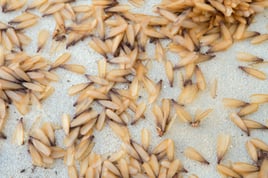Termites typically swarm in warm temperatures after a period of rain – conditions we are currently experiencing here in Massachusetts. This could be the only time of year, and the only way, to know if you have a termite infestation. Here’s what you should know to Protect Your Pad from termites this season.
 What to Watch For
What to Watch For
- Translucent wings on floors and near windows
- Live or dead insects near basement sill
- Detached wings
- Swarming/flying insects near windows
- Live, whitish insects in mulch beds/under stones
Am I Inviting Termites to My Home?
There are a number of elements around your home that may be attracting termites, including:
Wood piles: Store wood away from the home and preferably off the ground.
Dead trees and stumps: Damp, rotting, or dead trees and stumps provide an ideal food source.
Moisture: Leaky plumbing, inside or out, provides critical water sources. Gutters clogged with leaves and other debris help termites gain access to your home.
Tree limbs and leaves: Foliage touching your home, particularly near the roof line, acts as a highway from the ground to the indoors.
Direct access: Cracks and crevices in foundation, gaps around pipes and utility lines, and openings around windows and doors provide easy access. Termites only need an opening of about 1/32nd of an inch to get in.
What Should I Do If I Suspect a Termite Infestation?
While addressing the issues listed above can help to reduce the likelihood of termites making themselves at home, termite control is not a do-it-yourself project. By attempting to treat termites with over-the-counter products, you could make it harder to eliminate the colony, even for seasoned professionals. Call the termite experts at Burgess Pest at the first sign of a problem – with nearly a century of experience in identifying, eliminating, and preventing termite infestations, we’ve got what it takes to Protect Your Pad from these tiny terrors all year long.


